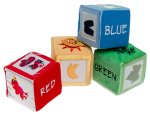
« PREVIOUS ENTRY
Houston, we have a problem
NEXT ENTRY »
Are you okay?

One of my favorite Onion stories is “Study Reveals: Babies Are Stupid”, in which scientists give intelligence tests to 3,500 babies and conclude that the infants are “so stupid, it’s not even funny.” It’s a neat parody of the inherent strangeness of the infant mind: When it comes to tiny children, the quirks of their uninformed behavior can seem either dumb as hell — or cognitively intriguing.
As an example of the latter, Judy S. DeLoache has published a totally fascinating piece in Scientific American discussing her research into children’s ability to engage in “symbolic thinking”. She started out by noticing that many infants younger than one year frequently assume a realistic color picture of an object is the object: In experiments, she’s found that infants will try to pick up a photographic object, or even try to stick their feet into a photograph of a shoe. Obviously, the kids can’t tell a picture from reality; they cannot separate the symbol of an object from the thing itself.
But things got really interesting in the next phase of DeLoache’s work. She brought a bunch of 18-to-30-month-old kids into a room where they could play with a set of toys: an indoor slide, a child-size chair and a car they could ride in. Then she took the children out for a break, and while they were out of the room, replaced the toys with identical, minature versions. When the kids came back in …
… they attempted with apparent seriousness to perform the same actions with the miniature items that they had with the large ones. Some sat down on the little chair: they walked up to it, turned around, bent their knees and lowered themselves onto it. Some simply perched on top, others sat down so hard that the chair skittered out from under them … A few kids tried to get into the tiny car. Just as they had done with the large version, they opened the door and attempted — often with remarkable persistence — to force a foot inside. One little girl went so far as to take off her shoe in the apparent hope that her foot would then fit!
This research has enormous implications for any field where adults have to interact with children. For example, consider the way social workers, while interviewing a child about possible sexual abuse, will ask a child to point to a doll to show how and where they were touched. The problem, DeLoache argues, is that many young children won’t have the ability to symbolically map their body onto a doll’s body; and in fact, controlled studies have found that children make fewer errors when simply describing verbally what happened to them — since they don’t need to manipulate symbols to do so.
Education’s another big area. When teachers try to show kids subtraction or addition, they typically use objects — like coins, sticks, whatever — to represent quantities. But DeLoache suspects many children cannot easily yet separate the symbolic nature of numbers — the “threeness” of a trio of apples, for example — from the actual objects themselves. In an even more mindblowing experiment, she taught two groups of six-and-seven-year-old kids to do subtraction problems that involve borrowing, a rather sophisticated concept. One group of kids was taught using pencil and paper; the other was taught using blocks. Both groups learned the concept, but the kids with blocks took three times longer. Why? Because learning the concept with pencil and paper requires the kids to immediately interact with abstract symbolic concepts. The kids working with blocks, paradoxically, had to do more mental work — since they had to separate the concept of numbers from the blocks they were working with.
That’s delightfully counterintuitive. We normally assume that teaching math using these sort of visual aids makes things easier, not harder. If DeLoache’s work holds up under scrutiny, it ought to have a massive impact on preschool and primary-school education.
(Thanks to Arts and Letters Daily for this one!)
I'm Clive Thompson, the author of Smarter Than You Think: How Technology is Changing Our Minds for the Better (Penguin Press). You can order the book now at Amazon, Barnes and Noble, Powells, Indiebound, or through your local bookstore! I'm also a contributing writer for the New York Times Magazine and a columnist for Wired magazine. Email is here or ping me via the antiquated form of AOL IM (pomeranian99).

ECHO
Erik Weissengruber
Vespaboy
Terri Senft
Tom Igoe
El Rey Del Art
Morgan Noel
Maura Johnston
Cori Eckert
Heather Gold
Andrew Hearst
Chris Allbritton
Bret Dawson
Michele Tepper
Sharyn November
Gail Jaitin
Barnaby Marshall
Frankly, I'd Rather Not
The Shifted Librarian
Ryan Bigge
Nick Denton
Howard Sherman's Nuggets
Serial Deviant
Ellen McDermott
Jeff Liu
Marc Kelsey
Chris Shieh
Iron Monkey
Diversions
Rob Toole
Donut Rock City
Ross Judson
Idle Words
J-Walk Blog
The Antic Muse
Tribblescape
Little Things
Jeff Heer
Abstract Dynamics
Snark Market
Plastic Bag
Sensory Impact
Incoming Signals
MemeFirst
MemoryCard
Majikthise
Ludonauts
Boing Boing
Slashdot
Atrios
Smart Mobs
Plastic
Ludology.org
The Feature
Gizmodo
game girl
Mindjack
Techdirt Wireless News
Corante Gaming blog
Corante Social Software blog
ECHO
SciTech Daily
Arts and Letters Daily
Textually.org
BlogPulse
Robots.net
Alan Reiter's Wireless Data Weblog
Brad DeLong
Viral Marketing Blog
Gameblogs
Slashdot Games